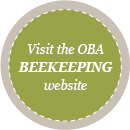Student Activities
The Honey Bee paper contains a great deal of information about honeybees and the way in which a hive operates. By no means does it cover all of the information available about this most fascinating member of the insect family. Much of what is provided here is for the information of the classroom teacher. You can decide what parts you wish to include in your study of the honeybee with your students.
As a follow-up to your classroom activities, a field trip to an actual apiary with your students, is highly recommended. The Bee Space program at your Kortright Centre for conservation is excellent. View more activities for the classroom.
Student Activities
Honey Bingo
Download a print the Honey Bingo Template for your students. Have the students put words associated with honeybees in the vacant spaces. You can use the ones supplied here or make up your own. In one container put the letters H.O.N.E.Y. and in another container put the words used to fill in the chart. Draw out one of the HONEY letters and one of the words and read them out to the class. For example, if the letter O and the word Drone were drawn, you would announce "under the O, Drone". Students would cross off the word Drone on their chart, only if they had it in column O. Return the letter and word to their respective containers and draw again. Continue in this manner until someone has crossed off a complete vertical, horizontal or diagonal row. When this happens the student yells out "HONEY". They are the winner. The space in the middle is a free space for everyone.
Co-Operation
Honeybees are called "social insects" because they live in a society that depends upon co-operation of all of the individuals living in the hive. Humans live in a social society as well.
- Have the students fill in the Busy as a Bee worksheet. From this have them write a short essay on their responsibilities at home and the responsibilities of other members of their family.
- Have the students give a short report verbally or in written form about how other groups co-operate for the good of the whole. Examples could be from sports teams or other members of the animal kingdom.
- Have your students work in groups co-operatively to produce reports on honeybees for the rest of the class. They could do a collage of pictures, a mural, make an audio tape, develop work sheets for other students to complete (word searches, puzzles, mazes, etc.) Each person in the group could have a special responsibility.
Busy as a Bee
Honeybees are called social insects because different members of the colony have special jobs which help the entire colony. List some of your chores which help your family;
--------------------------------------------------------------------------------
--------------------------------------------------------------------------------
--------------------------------------------------------------------------------
--------------------------------------------------------------------------------
--------------------------------------------------------------------------------
Pollination
Honeybees are important agents in the pollination of flowering plants which is necessary if that plant is to produce a fruit or seeds.
- Give your students the outline of the parts of a simple flower and have them put the names of the parts on the outline.
- Have the students bring in fruits of various kinds (apple, pear, orange, cucumber, strawberry, tomato, etc.) and ask them to find the seeds within the fruit. Try planting some of the seeds and see what happens. Have the students do a drawing of the life cycle of their favorite fruit.
- Pollen can be collected by students on a pollen board (a piece of cardboard covered by a dark coloured piece of corduroy, velveteen, or felt). Have the students gently rub or press flowers against the board to see what the pollen looks like. How many different colours of pollen can you find? Remember to tell the students to only bring in one sample of each plant. We do not want to have them destroying whole communities of flowers. Explain that flowers have pollen only at certain times of the year, so some flowers may not contain pollen today. Discuss how the honeybee's hairy body picks up pollen from one flower and transfers it to another. What might happen to plants if there were no honeybees.
Communication
Honeybees communicate in a very complex way. The distance and direction of a source of pollen or nectar is communicated to other workers through special dances. We communicate in a variety of ways such as talking, writing, drawing, body language, facial expressions.
- Give the students some words associated with honeybees and have them draw a picture on the chalkboard to explain the term. No words are allowed. Some suggested terms could be:
| dancing | honeybee | worker | queen |
| drone | pollination | hive | fruit |
| apple | sting | honeycomb | pollen |
| flower | wings | nectar | wax |
| seed | extractor | pupa | pollen basket |
- Body language says a great deal about what a person is thinking or how they are feeling. Have the students display different postures at the front of the classroom and see if other students can guess what they are trying to display. Cut out pictures from old magazines that show different facial or body expressions and display them in the classroom. Put a caption beneath each of the pictures describing what feeling is being communicated.
- Play a game of charades using ideas associated with honeybees.
Visit additional sites that host educational material on honey and honey production.



